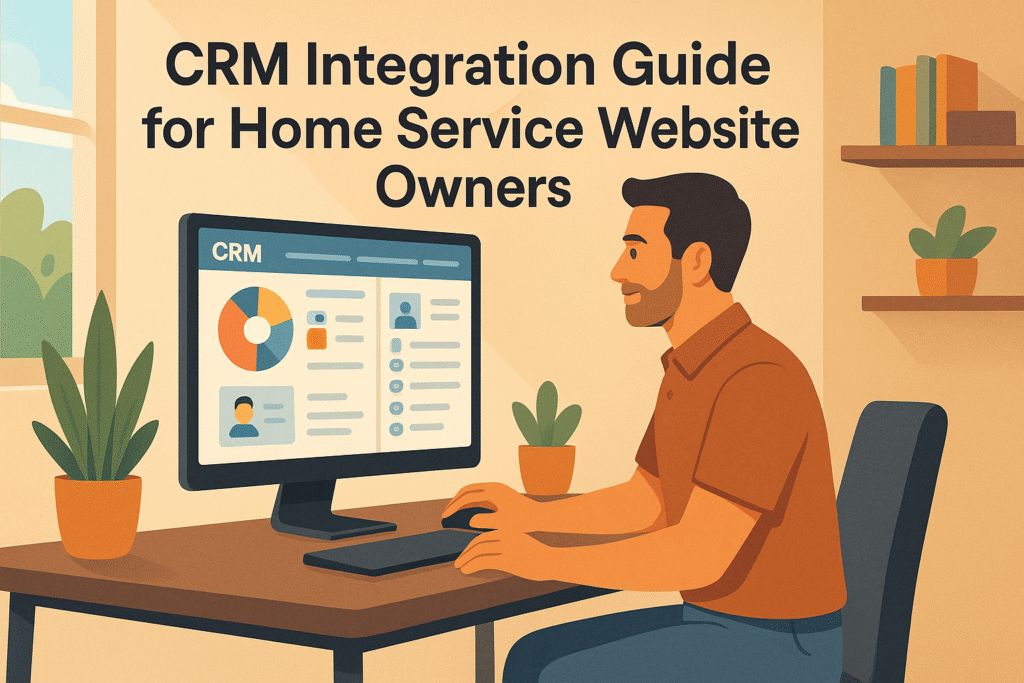Want to grow your home service business? A CRM system can help you manage leads, improve customer communication, and boost sales. With features like automated follow-ups, scheduling tools, and mobile access, it simplifies your operations and keeps customers happy.
Here’s what you’ll learn:
- Why CRM matters: Businesses earn $8.71 for every $1 spent.
- Key benefits: 29% higher sales, 34% better productivity, and 47% improved customer satisfaction.
- Top tools: Compare options like JobNimbus ($25/month), BuilderPrime ($99/month), and ServiceMonster ($39/month).
- How to set it up: From lead capture forms to automation, get step-by-step guidance.
A CRM isn’t just software – it’s a tool to save time, close more deals, and keep customers coming back.
How to Use a CRM System the Right Way
How CRM Integration Helps Home Service Businesses
A CRM system simplifies operations, keeps track of leads, and improves customer interactions.
Smarter Lead Management
A CRM automatically organizes and tracks every lead from your website. Research shows that 80% of sales require five follow-ups to close, but only 8% of salespeople follow through on those steps.
Here’s how a CRM improves lead management:
- Automatically captures and organizes customer details
- Sends instant notifications for new leads
- Sets reminders for follow-ups
- Provides a clear pipeline view to prioritize leads effectively
"A CRM platform is a tool that makes it easy to keep track of sales opportunities, including new leads, open estimates, and repeat business. It stores information about your customers and handles all the data, so you can just focus on your growing business." – Housecall Pro
These features help ensure no lead falls through the cracks, making customer communication easier and more effective.
Streamlined Customer Communication
CRMs centralize all customer interactions, making it easier to maintain consistent communication. This approach has helped 47% of CRM users report better customer satisfaction and retention.
Some key features include:
- Tracking all interactions on a single dashboard
- Automating appointment reminders
- Sending tailored service recommendations
- Managing customer feedback and reviews
- Coordinating team communication for specific clients
Boosted Sales and Productivity
Beyond organizing leads and communication, CRMs can boost sales by 29% and improve productivity by 34%. On average, businesses earn $8.71 for every dollar spent on a CRM system.
Here’s how CRM systems contribute to better results:
| Factor | Impact |
|---|---|
| Increased Productivity | Up to 34% |
| Higher Sales Growth | 29% average increase |
| Mobile CRM Usage | Boosts productivity by over 25% |
| ROI | $8.71 per dollar spent |
CRMs also track essential metrics like average close time, job value, and conversion rates, helping businesses identify their most profitable customer segments and refine their sales strategies.
How to Add CRM to Your Website
Pick the Right CRM System
Choosing the right CRM system is key to running your home service business efficiently. Look for tools tailored to contractors and home service providers. Here are some factors to consider:
| Feature Category | What to Look For |
|---|---|
| Industry Fit | Features designed for construction or home services |
| Budget Range | Monthly costs between $25 and $150 per user |
| Integration Options | Built-in website connectors or API access |
| Mobile Support | Mobile compatibility and offline access |
| Automation | Tools for lead capture, follow-ups, and scheduling |
Some CRMs are built specifically for home service businesses. For instance, JobNimbus starts at $25 per user per month, while Builder Prime offers specialized features starting at $79 per month.
Once you’ve selected the right CRM, it’s time to get your website ready to take full advantage of it.
Set Up Your Website
After picking the CRM, ensure your website can collect and transfer data smoothly. Here’s how:
-
Design Lead Capture Forms: Create forms that collect essential details, such as:
- Name, phone number, and email
- Service type or interest
- Appointment preferences
- Project details
- Budget range
- Configure Data Fields: Match your form fields with your CRM’s data structure to ensure the information flows correctly.
- Install Tracking Tools: Add tracking codes and analytics to monitor lead sources and customer interactions.
Connect and Test Your CRM
To finalize the integration, make sure data flows smoothly and automation works as intended. Use one of these integration methods:
- Built-in Connectors: Many CRMs have direct website integration options.
- Connector Platforms: Tools like Zapier can link your website and CRM, allowing for custom workflows.
- API Integration: For complex needs, APIs offer maximum flexibility.
Once everything is set up, test the following:
- Form submissions and data accuracy
- Automation workflows and triggers
- Notifications and alerts
- Mobile functionality
A properly integrated CRM can simplify lead management and improve conversions, making it a powerful tool for your business.
sbb-itb-e2efe4f
Best CRM Tools for Home Service Companies
Must-Have CRM Features
Here are some key features that home service businesses should look for in a CRM:
| Feature Category | Description | Business Impact |
|---|---|---|
| Mobile Access | Apps designed for field use, including offline access | Keeps teams connected and updated at job sites |
| Lead Management | Tools for tracking contacts and automating follow-ups | Helps boost conversions and avoid missed leads |
| Scheduling | Automated booking and dispatch management | Prevents scheduling conflicts and improves coordination |
| Customer Communication | Two-way SMS, email automation, and notifications | Improves customer interactions and reduces missed appointments |
| Financial Tools | Payment processing and invoice management | Simplifies billing and supports better cash flow |
"The best CRM software will help you manage your relationships with prospects and customers. It empowers you to ensure every touchpoint sends out more of those feel-good, happy-customer vibes."
- Kevin Talley, Content Expert
Now let’s dive into some specific tools to help you make the right choice.
CRM Tool Comparison
Here’s a quick look at some of the top CRM options for home service businesses:
ServiceMonster
- Cost: $39/month
- Designed for field services
- Features include mobile-first design and scheduling optimization
- Cost: $99/month (includes 1 user)
- Tailored for remodelers and contractors
- Offers lead generation and reputation management tools
- Capterra Rating: 4.2/5
BuilderPrime
- Cost: $99/month
- Built as an all-in-one solution for contractors
- Known for its comprehensive business management features
- Capterra Rating: 4.8/5 (highest-rated in the category)
"BuilderPrime can do 90% of what other CRMs can do at about 10% of the cost."
- Former Client of BuilderPrime
Most of these tools offer free trials, so you can test scalability and features before committing.
Additional features to look for include:
- Automated task management to keep workflows efficient
- Customer segmentation for more precise marketing efforts
- Customizable reporting to track key business metrics
- Integration options to connect with your existing tools and systems
San Diego Business Requirements
Local Business Settings
Set up your CRM with these key configurations tailored for San Diego businesses:
| Setting Category | Configuration | Business Impact |
|---|---|---|
| Time Zone | Pacific Time (PT) | Ensures accurate scheduling and notifications |
| Currency | USD (including California’s 7.75% base tax) | Aligns with California sales tax regulations |
| Service Areas | San Diego County zones | Improves route planning and territory management |
| Compliance | CCPA guidelines | Ensures proper handling of customer data |
Enable automatic time zone detection to avoid scheduling errors, especially critical in San Diego’s diverse service areas, from La Jolla to Chula Vista. Travel times in this region can heavily influence appointment planning.
Studies show that 38% of businesses fail to prioritize a strong customer relationship strategy. Use these localized settings to align your CRM with marketing strategies that resonate with San Diego’s unique neighborhoods.
Local Marketing Tools
Optimize your CRM to boost engagement in San Diego’s home service market.
Neighborhood-Specific Segmentation:
- Coastal areas like La Jolla and Pacific Beach
- Inland communities such as Scripps Ranch and Mira Mesa
- Downtown districts
- South Bay regions
Seasonal Campaign Automation:
- Spring maintenance (March–May)
- Pre-summer AC tune-ups
- Fall readiness
- Winter weather-proofing
Local Integration Features:
- Weather alerts for scheduling adjustments
- San Diego-specific permit requirements
- California contractor license validation
- Listings in local business directories
A notable 65% of customers have switched providers due to poor service experiences. To prevent this, ensure your CRM supports mobile access for field teams working across San Diego’s extensive territories.
Fine-tune your CRM’s reporting tools to monitor:
- Response times by neighborhood
- Service completion rates during busy seasons
- Customer retention trends by district
- Revenue performance across service areas
This targeted approach not only strengthens customer satisfaction but also keeps your business in line with California’s consumer protection rules.
Summary
CRM integration offers an impressive return of $8.71 for every dollar spent, while boosting both sales and productivity. To make the most of it, follow these key steps:
-
Assessment and Selection
Start by identifying your specific needs – consider service areas, team size, and communication preferences. Research shows that 47% of CRM users experience better customer satisfaction and retention. -
Implementation Strategy
Set up the system correctly by focusing on:- Configurations tailored to your business
- Comprehensive team training
- Careful planning for data migration
- Connecting the CRM with your existing tools
-
Optimization and Growth
Regularly review and fine-tune your CRM. Mobile access, for example, can increase field productivity by over 25%, which is especially useful for meeting the diverse demands of San Diego’s market.
FAQs
How does a CRM system enhance customer satisfaction and loyalty for home service businesses?
A CRM system helps home service businesses deliver exceptional customer experiences by centralizing all customer interactions and data. This makes it easier to provide timely, personalized communication, ensuring customers feel valued and understood.
With features like automated follow-ups, appointment reminders, and service history tracking, a CRM ensures smoother operations and quicker responses. These improvements lead to higher customer satisfaction, increased trust, and ultimately, greater loyalty to your business.
What should home service website owners look for in a CRM system to meet their business needs?
When choosing a CRM system, home service website owners should focus on features that align with their specific business operations. Key factors to consider include ease of use, lead management capabilities, and tools for streamlining communication with customers.
Additionally, look for a CRM that integrates seamlessly with your existing website and supports your workflow, such as scheduling, invoicing, and follow-ups. A good CRM should help you save time, improve customer satisfaction, and increase conversions by organizing your client interactions and automating routine tasks.
How can I integrate a CRM system with my home service website effectively?
Integrating a CRM system with your home service website can significantly improve lead management and customer communication. To do this successfully, follow these key steps:
- Choose the right CRM: Select a CRM tailored to home service businesses, such as HubSpot, Salesforce, or Jobber, ensuring it meets your specific needs like scheduling, lead tracking, or customer follow-ups.
- Connect your website and CRM: Use plugins, APIs, or built-in integrations provided by your CRM to link it to your website. This enables seamless data transfer, such as capturing leads from contact forms directly into your CRM.
- Customize your CRM settings: Set up workflows, automation, and fields to match your business operations. For example, automate appointment confirmations or follow-up emails.
- Test and optimize: After integration, test the system to ensure everything works smoothly. Monitor performance and make adjustments as needed to improve efficiency.
By integrating a CRM, you can streamline operations, enhance customer interactions, and ultimately boost conversions for your home service business.



